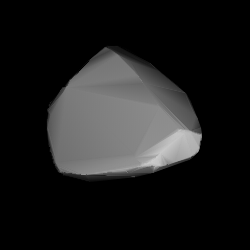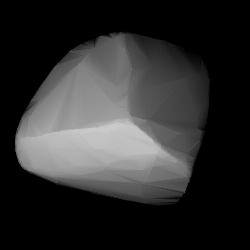Related Research Articles
2807 Karl Marx, provisional designation 1969 TH6, is a carbonaceous Dorian asteroid from the central region of the asteroid belt, approximately 17 kilometers in diameter. It was discovered on 15 October 1969, by Russian astronomer Lyudmila Chernykh at the Crimean Astrophysical Observatory in Nauchnyj on the Crimean peninsula. The asteroid was later named for the German philosopher Karl Marx.
2598 Merlin, provisional designation 1980 RY, is a carbonaceous Dorian asteroid from the central regions of the asteroid belt, approximately 16 kilometers in diameter. It was discovered on 7 September 1980, by American astronomer Edward Bowell at Lowell's Anderson Mesa Station in Flagstaff, Arizona, United States. The asteroid was named after the legendary wizard Merlin in Arthurian legend.
Adelaide is an S-type asteroid belonging to the Flora family in the Main Belt. It was discovered 21 October 1908 by Joel Hastings Metcalf.
657 Gunlöd is a dark background asteroid orbiting in the intermediate asteroid belt, approximately 43 kilometres (27 mi) in diameter. It was discovered on 23 January 1908, by astronomer August Kopff at the Heidelberg Observatory in southwest Germany. It has an albedo of around 0.042 and a rotation period of 15.7 hours.
658 Asteria is a minor planet orbiting the Sun.
661 Cloelia is a minor planet orbiting the Sun that was discovered by American astronomer Joel Hastings Metcalf on February 22, 1908.
660 Crescentia is a minor planet orbiting the Sun that was discovered by American astronomer Joel Hastings Metcalf on January 8, 1908. The name may have been inspired by the asteroid's provisional designation 1908 CC. Peter Ting points out that the Rev. Joel Metcalf of Taunton (Massachusetts) discovered six asteroids with unexplained names, though listed in Lutz Schmadel's book. Ting used an on-line planetarium website to help with the location of some of the planets, playing back to the night of discovery. He noticed that there was a crescent moon (33%) low in the western sky and wonders if the Rev. Metcalf could have named the asteroid for the Moon. Crescentia would be a very unusual name for a person but not for a phase of the Moon.

662 Newtonia is a minor planet, specifically an asteroid orbiting mostly in the asteroid belt.
663 Gerlinde is a minor planet orbiting the Sun.
664 Judith is a minor planet orbiting the Sun. It was named after the biblical character Judith.
667 Denise is a minor planet orbiting the Sun. The name may have been inspired by the asteroid's provisional designation 1908 DN.

669 Kypria is a minor planet orbiting the Sun that was discovered by German astronomer August Kopff on August 20, 1908.
671 Carnegia is a minor planet orbiting the Sun.
672 Astarte is a minor planet orbiting the Sun.

673 Edda is a minor planet orbiting the Sun. It was discovered 20 September 1908 by the American astronomer Joel Hastings Metcalf, and was named for the Norse Edda literary works. The name may also have been inspired by the asteroid's provisional designation 1908 EA. This asteroid is orbiting at a distance of 2.81 AU with a period of 4.72 yr and an eccentricity of 0.012. The orbit is close to a 5:2 mean motion resonance with Jupiter, which is located at 2.824 AU.
670 Ottegebe is a minor planet orbiting the Sun. In 2007 lightcurve data showed that Ottegebe rotates every 10.041 ± 0.002 hours. The name refers to a character in Gerhardt Hauptmann's play Der arme Heinrich. It is orbiting close to a 5:2 mean motion resonance with Jupiter, which is located at 2.824 AU.
972 Cohnia is a minor planet orbiting the Sun, one of several such in the asteroid belt. It was discovered on 18 January 1908 by a team in Heidelberg led by Max Wolf. In 2007, lightcurve data showed that Cohnia rotates every 18.472 ± 0.004 hours.
4354 Euclides, provisional designation 2142 P-L, is a dark Dorian asteroid from the central regions of the asteroid belt, approximately 12 kilometers in diameter. It was discovered on 24 September 1960, by Dutch astronomer couple Ingrid and Cornelis van Houten on photographic plates taken by Dutch–American astronomer Tom Gehrels at Palomar Observatory in California. The likely C-type asteroid was named after the Greek mathematician Euclid.
Bacon, provisional designation 3042 P-L, is a carbonaceous Dorian asteroid from the central region of the asteroid belt, approximately 9 kilometers in diameter. It was discovered on 24 September 1960, by Ingrid and Cornelis van Houten at Leiden, and Tom Gehrels at Palomar Observatory in California, United States. It was later named after English philosopher and statesman Francis Bacon.
1414 Jérôme, provisional designation 1937 CE, is a carbonaceous Dorian asteroid from the central region of the asteroid belt, approximately 16 kilometers in diameter. It was discovered on 12 February 1937 by, French astronomer Louis Boyer at Algiers Observatory, Algeria, in northern Africa, and named after his father Jérôme Boyer.
References
- ↑ Noah Webster (1884) A Practical Dictionary of the English Language
- ↑ "668 Dora (1908 DO)". JPL Small-Body Database . NASA/Jet Propulsion Laboratory . Retrieved 5 May 2016.